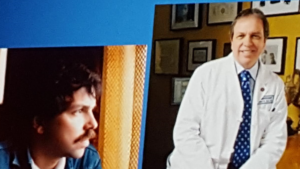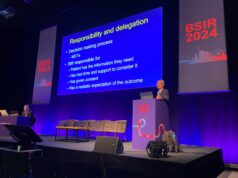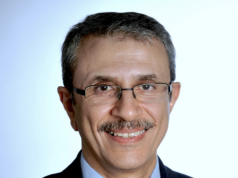
“There is no easy fix with current endovascular tools and strategies and a default realisation is that it is easier and more definitive to treat aortic dissection early,” Michael D Dake, Stanford, USA, told Interventional News about the Achilles’ heel of thoracic endovascular aneurysm repair (TEVAR) management for uncomplicated type B dissection.
“At present we are armed with a tool box of largely unproven and often complicated multi-step therapies and a ‘wait and see’ approach that satisfies no one. Future success will require new ideas and creative thinking,” he said while talking about TEVAR’s dirty little secret. The paradigm for treatment might need to be radically re-thought, he added.
Dake received the British Society of Interventional Radiology (BSIR)’s Honorary Fellowship at the society’s annual meeting (15–17 November 2016, Manchester, UK). Dake is the Thelma and Henry Doelger Professor (III), Department of Cardiothoracic Surgery, Stanford University School of Medicine, Falk Cardiovascular Research Center. He delivered a lecture on aortic dissection, speaking on the topic “Endovascular Management of Aortic Dissection: What We Know, Think We Know and Need to Know”.
There are three main strategies for uncomplicated type B aortic dissection: medical management alongside a “wait and watch” approach for complications to occur, after which treatment is undertaken; early endovascular treatment for all patients; and early endovascular treatment only for patients at high-risk of complications.
“In all initially uncomplicated type B dissections, should we look for high risk features that predict early progression or just plan to treat all except those in whom the procedure may be difficult or at risk of complication?,” Dake questioned.
The clinical course of type B uncomplicated aortic dissection is not entirely benign. Early TEVAR will benefit some high risk patients who can be identified by predictive factors. Accumulating evidence may favour even more liberal early TEVAR in type B dissection, but the timing of the intervention and its cost-effectiveness still remain questions, Dake told attendees.
“We are not providing a definitive treatment for dissection. In some fraction of patients after TEVAR, we know that there is going to be persistent false lumen perfusion from abdominal branches that can, not only continue to provide a risk for the patient in terms of rupture, but also lead to dilatation and false lumen aneurysm formation. Trying to really excommunicate the false lumen aneurysm in a chronic state is really difficult to do with our current toolbox,” Dake informed Interventional News.
“I think we need to think about this differently. Yes, we now have stent grafts in the tool box and we can use these even in the branches, but it is very difficult to achieve good results in a chronic state. Even experts who have a lot of experience using branched grafts in chronic dissections understand that endoleaks still exist and that branch vessel grafts still occlude. There has got to be a way to deal with this upfront and definitively so as not to have a long tail of potential complications and so that the false lumen does not have the opportunity to be a bad actor in the chronic state. With the current tools that we have, we just do not have the opportunity to do that. People have tried many kinds of gizmos and gadgets to plug the false lumen, but these seem to only work in the acute setting when the lamella is thin and weak. In the chronic setting some combination technologies such as the use of extreme tapers and reverse tapers with distal cutting that seek to rupture the dissection septum could be risky. I think we need to think of a new paradigm that will probably include stent grafts at some level, but it may have to be radically rethought. First, there needs to be the understanding that what we are providing in a subgroup of patients, is inadequate. With that realisation, which shows that that stent grafts are not a panacea, we can move ahead and truly create a more definitive solution without constant surveillance and the risk that there is going to be late progression.”
The challenge of undertaking dissection trials
“Because dissections are relatively rare, in order to obtain data from a large number of patients, the trial will need to have a large number of participating centres who are interested in aortic disease and experienced in both open and endovascular treatments. When you have that many institutions participating, there are going to be expenses and the issue is who is going to foot the bill. Trials that are being reported are basically industry-sponsored. Industry has to do these trials to get approval for their devices so funding these trials is part of a business strategy. However, once approval is obtained, industry really does not have the same motivation or incentive to fund the trials that we need to have done for the doctors and patients. In the climate of decreasing resources for research it takes a lot of coordination to muster the resources to carry out these trials,” Dake concluded.













